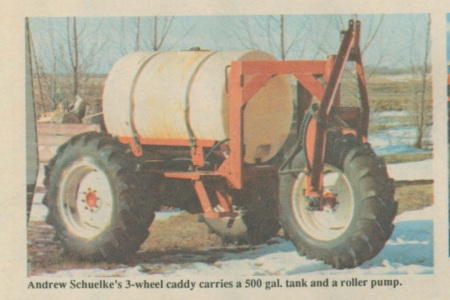
"These home-built tricycle sprayer caddies incorporate herbicides accurately and cost very little to build," says Roger Schuelke, Marietta, Minn., about the rigs he and his brother Andrew built last winter, borrowing the tires and drive lines off two old Case 960 combines.
Roger's 4-wheel caddy, with two rear 18.4 by 26 combine tires and two front 10.00 by 20 front tires, holds a 750 gal. poly tank. He pulls the caddy behind a Versatile 800 4-WD tractor and 43-ft. field cultivator.
Andrew's 3-wheel caddy, with three 18.4 by 26 combine tires, holds a 500 gal. poly tank. He pulls the caddy behind a Ford TRS 35 tractor and a 30-ft. field cultivator.
On both caddies, the combine's original 3-speed transmission drives a sprayer pump, sending chemicals to booms on the cultivators. To put the transmissions in gear, the brothers simply flip a lever, enabling the transmission to turn the shaft that normally would turn the combine's clutch. Roger runs the transmission in second gear to power a centrifugal pump; Andrew runs in third gear, to power a roller pump.
Roger used the sprayer caddy last spring on 420 acres of soybeans.
According to Roger, the homemade sprayer caddy works better than commercial equipment with ground driven positive displacement pumps. "Those pumps are accurate, but expensive. The pump alone costs more than it cost me to build my whole caddy. What's more, commercial caddies with ground driven pumps aren't equipped with an agitation system. Mine is. I can keep chemicals suspended while I'm traveling, and if the tank sets for a while I simply pull the caddy down the field to agitate it," Roger points out.
The drive line, 10 ft. long and 4 ft. wide, consists of the transmission, bell housing, and planetary gears. To hold the drive line, Roger built a frame from 6-in. channel iron, adding a floor made of 2 by 10 boards. Then, he installed the 750 gal. poly tank, using cable to strap it to the frame.
He then built a short gooseneck which extends 18 in. ahead of the flatbed and is attached to a pivot point between the two 10.00 by 20 truck tires. Roger made the pivot point by welding the tires' spindles back to back, hubs facing outside. He welded the spindles on the bottom of a 4-in. (outside dia.) pipe and slipped a piece of 4-in. (inside dia.) pipe over it.
The tires on both caddies are on 120 in. centers and can straddle 30-in. rows perfectly, says Roger. "Andrew's home-built caddy, with a single front wheel, could even be pulled behind a mounted planter to apply liquid starter fertilizer."
